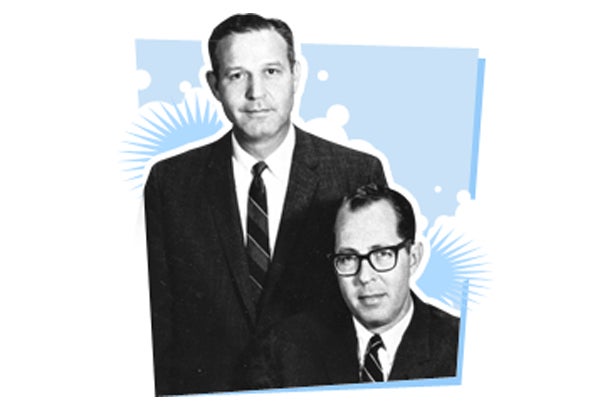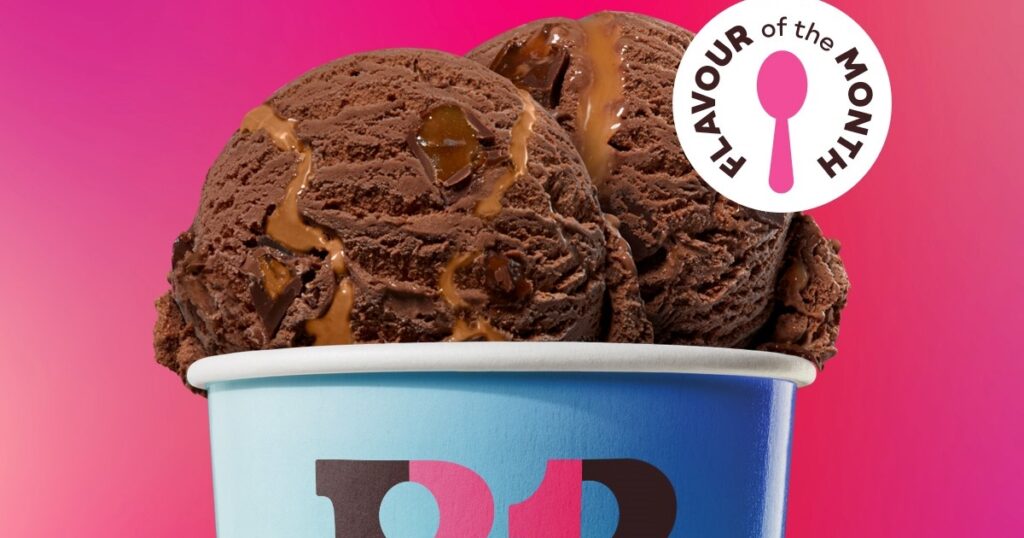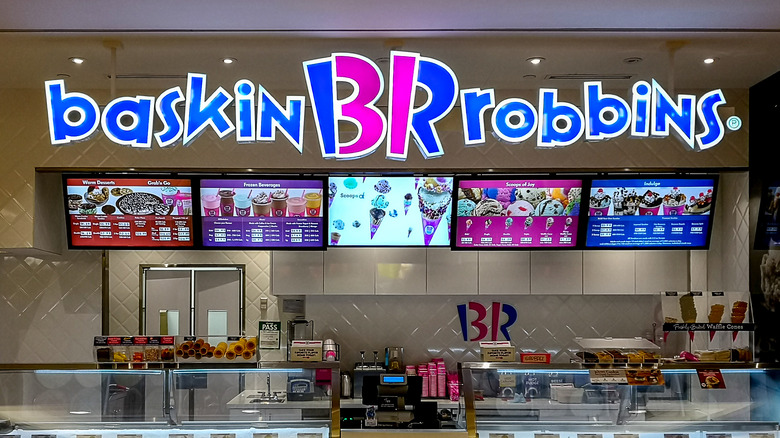Baskin-Robbins is an American multinational chain of ice cream and cake specialty shops owned by Inspire Brands. Baskin-Robbins was founded in 1945 by Burt Baskin and Irv Robbins in Glendale, California. Its current headquarters are in Canton, Massachusetts, and shared with sibling brand Dunkin’ Donuts. It is the world’s largest chain of ice cream specialty stores, with more than 8,000 locations.

Baskin-Robbins is known for its wide selection of ice cream flavors. The company offers over 1,400 different flavors, with new flavors being introduced all the time. Baskin-Robbins also offers a variety of ice cream cakes and other frozen treats.
In addition to its ice cream products, Baskin-Robbins also offers a variety of other food and beverage items, such as milkshakes, smoothies, and coffee. The company also has a line of frozen yogurt and sorbet products.
Baskin-Robbins is committed to providing its customers with a fun and inviting experience. The company’s stores are designed to be family-friendly and welcoming. Baskin-Robbins also offers a variety of promotions and events throughout the year, such as its famous “Flavor of the Month” promotion.

Baskin-Robbins is a popular brand all over the world. The company’s products are enjoyed by people of all ages and backgrounds. Baskin-Robbins is committed to providing its customers with the best possible ice cream experience, and the company continues to grow and innovate.
Marketing Strategies of Baskin-Robbins
Baskin-Robbins, one of the world’s most iconic ice cream and frozen dessert chains, employs a variety of marketing strategies to maintain its strong brand presence and satisfy the sweet cravings of its customers. Let’s explore the key elements of Baskin-Robbins’ marketing strategies in detail:
1. Product Innovation
Baskin-Robbins, a leading ice cream chain known for its extensive flavor library, leverages product innovation as a key component of its marketing strategy. Here’s how it does so effectively:
Seasonal Flavors: Baskin-Robbins introduces seasonal flavors throughout the year, capturing consumers’ interest during holidays, special occasions, and weather changes. For instance, pumpkin spice latte, eggnog, and candy cane flavors are popular during fall and winter seasons, while fruity and lighter options like strawberry, raspberry, and mango are featured in summer months.
Limited Time Offerings (LTO): Baskin-Robbins regularly launches LTOs, offering exclusive flavors available only for a limited period. This creates excitement among customers who want to try new taste sensations before they disappear. It also encourages repeat visits and word-of-mouth promotion.
Customizable Options: To appeal to diverse tastes and dietary requirements, Baskin-Robbins offers customizable ice cream sundaes, milkshakes, and cups. Consumers can choose their favorite base, add-ins, sauce, and toppings, making each dessert personalized and memorable.
Ice Cream Cake Creations: Baskin-Robbins capitalizes on celebratory moments by providing customizable ice cream cakes for birthdays, weddings, graduations, and other milestones. Its wide range of designs, shapes, sizes, and flavors caters to varying preferences and budgets.
2. Targeted Segmentation
To reach specific consumer segments more effectively, Baskin-Robbins employs targeted segmentation strategies within its overall marketing approach. The following examples illustrate this technique:
Kids and Families: Baskin-Robbins recognizes the importance of appealing to families with young children, who often visit the store for fun outings or after school treats. As such, the company has developed kid-friendly flavors like Chocolate Chip Mint, Very Berry Strawberry, and Rainbow Sherbet, as well as colorful cones and spoons designed for little hands. Additionally, Baskin-Robbins frequently hosts family-oriented promotions, contests, and events to attract this group.
Health-Conscious Individuals: With growing concerns over sugar consumption and nutrition, Baskin-Robbins addresses the needs of health-conscious individuals through low-fat, low-calorie, and dairy-free options. The brand features “Skinny Cow” products made from real milk and reduced fat ingredients, as well as non-dairy sorbets crafted from natural fruit purees. Moreover, Baskin-Robbins emphasizes these choices on its website and in-store signage to make them easily accessible for interested patrons.
Premium Ice Cream Enthusiasts: Recognizing that some customers seek premium quality and unique flavor experiences, Baskin-Robbins offers artisanal and small batch selections under its “Reserve” label. These limited edition flavors feature rare ingredients sourced from all over the world, such as black truffle, saffron, and Tahitian vanilla bean. Promoting Reserve flavors through social media, email newsletters, and in-store tastings helps attract discerning gourmands seeking exceptional frozen desserts.
Baskin-Robbins utilizes various marketing techniques to maintain its position as an industry leader and capture different consumer groups. From product development and pricing strategies to experiential marketing and targeted segmentation approaches, the brand demonstrates flexibility and adaptability in meeting evolving consumer preferences and expectations.
3. Loyalty Programs
Baskin-Robbins leverages loyalty programs as part of its broader marketing strategy to foster long-term relationships with customers and increase repeat business. Here are several ways the brand implements this approach:
Birthday Club: One of Baskin-Robbins’ most popular loyalty initiatives is its Birthday Club program, which provides members with special deals and perks on their birthdays. By signing up for free via email or text message, customers receive a complimentary scoop of ice cream during their birthday month, as well as exclusive offers throughout the year. This simple yet effective program generates goodwill, increases foot traffic, and encourages repeat visits.
Baskin-Robbins Rewards: Baskin-Robbins Rewards is Baskin-Robbins’ official loyalty program that lets customers earn points toward future purchases based on their spending history. For every dollar spent, participants accrue one point, which translates into $0.10 off future orders once reaching 100 points (equivalent to $1). Participants can enroll using their phone number or email address linked to a credit/debit card or gift card.
Personalization and Exclusivity: Through both the Birthday Club and Scoops Rewards, Baskin-Robbins tailors communications and benefits to individual customers based on their preferences and purchase histories. This level of personalization strengthens emotional connections between consumers and the brand while creating a sense of exclusivity around membership privileges.
Cross-Promotion Opportunities: Baskin-Robbins uses its loyalty programs to cross-promote complementary brands owned by parent company Inspire Brands, including Dunkin’ Donuts and Caribou Coffee. By integrating these partnerships into member communications and reward structures, Baskin-Robbins expands potential revenue streams and deepens customer engagement across multiple brands.
4. Partnerships and Co-branding
To expand its reach and appeal to new audiences, Baskin-Robbins has established various partnerships and co-branding efforts. Some examples include:
Collaborations with Iconic Brands: Baskin-Robbins frequently teams up with renowned companies to create limited-time menu items inspired by beloved characters, movies, TV shows, and games. For instance, tie-ins have included Hershey’s, Disney, Marvel, Star Wars, Pixar, and Nintendo properties, among others. These collaborations not only generate buzz but also provide opportunities for cross-promotions and increased visibility within each respective fan base.
Sports Sponsorships: As an Official Partner of the National Hockey League (NHL), Baskin-Robbins promotes its association through in-game activations, social media campaigns, and customized ice cream flavors featuring team logos and colors. Similar arrangements exist with Major League Baseball (MLB) clubs like the Boston Red Sox and Los Angeles Dodgers, further solidifying the brand’s presence in sports culture.
Charitable Alliances: To enhance its community involvement, Baskin-Robbins forms alliances with organizations focused on causes such as cancer research, children’s hospitals, and military support. For example, the brand participates in the annual World’s Largest Ice Cream Social event benefiting the American Cancer Society and supports local fundraisers at select locations nationwide.
Seasonal Campaigns: During holidays and seasonal occasions, Baskin-Robbins creates thematic menus and promotions designed to resonate with specific audiences. For example, the brand launched a lineup of festive Easter treats and introduced a selection of pumpkin-infused flavors leading up to Halloween and Thanksgiving. Such timely offerings encourage repeat visits and help keep the brand top-of-mind throughout the year.
5. In-Store Experience
In-store experience plays a crucial role in Baskin-Robbins’ marketing strategy. The brand focuses on providing a welcoming atmosphere, interactive elements, and unique product presentations to attract and retain customers. Here are some key aspects of Baskin-Robbins’ in-store experience:
Store Design: Each location features a brightly colored interior decorated with fun graphics and playful signage, emphasizing the brand’s whimsical personality. The layout typically includes visible display cases showcasing the signature 31 flavors, along with merchandising materials highlighting current promotions and seasonal products.
Interactive Elements: Many stores incorporate interactive components, such as touch screens displaying virtual menu boards and digital signage showcasing videos and animations. Additionally, some locations feature photo booth areas where customers can capture memories while enjoying their desserts.
Customizable Options: Baskin-Robbins offers a range of mix-ins and toppings, allowing customers to personalize their frozen treat experiences. Employees often wear aprons emblazoned with “Flavorologist” titles, emphasizing their expertise in guiding patrons through the extensive options available.
Gift Card Program: The brand’s gift cards serve as convenient gifts for friends and family, helping to extend the Baskin-Robbins experience beyond direct interactions with customers. Available in physical and digital formats, these cards contribute to overall sales and boost brand awareness.
6. Health-Conscious Offerings
With increasing consumer demand for healthier food choices, Baskin-Robbins has developed a variety of options catering to those seeking lighter or more nutritious alternatives without sacrificing taste. By offering health-conscious selections, the brand positions itself as adaptable to evolving customer preferences and attuned to changing dietary needs. Here are some ways Baskin-Robbins approaches this marketing strategy:
Low-Calorie/Diet-Friendly Flavors: The brand offers sugar-free and low-fat ice cream options, which appeals to calorie-counting individuals looking for indulgent yet manageable treats. Skinny Cow products are clearly marked on menu boards and promoted via dedicated point-of-purchase materials.
Non-Dairy Alternatives: Recognizing growing veganism and lactose intolerance, Baskin-Robbins provides non-dairy options made from almond milk or other plant-based ingredients. These options allow customers to enjoy similar flavors without compromising their dietary restrictions.
Fruit-Based Treats: The brand offers fruit-centric options like yogurt-covered strawberries, fresh berry sundaes, and fruit smoothie blends. Highlighting natural sweetness derived from fruits helps position these items as healthier choices compared to traditional ice creams.
Portion Control: Baskin-Robbins addresses portion control concerns by offering smaller sizes, minis, and kiddie cups, enabling customers to satisfy their cravings without overindulging. This approach caters to weight watchers who want to savor their favorite flavors in moderation.
Ingredient Transparency: Providing clear information about ingredients used in all menu items, including artificial coloring and preservative usage, demonstrates the brand’s commitment to open communication regarding product quality. This transparency fosters trust among health-conscious customers.
Marketing Mix of Baskin-Robbins
Baskin-Robbins effectively utilizes the marketing mix, often referred to as the 4Ps (Product, Price, Place, and Promotion), to maintain its strong market position and satisfy the cravings of its sweet-toothed customers. Let’s delve into the details of how Baskin-Robbins employs each element of the marketing mix:
Product
-
- Wide Flavor Variety: Baskin-Robbins is known for its extensive range of ice cream flavors, with each store offering up to 31 flavors, one for each day of the month. They continuously innovate and introduce new flavors to keep customers engaged.
- Customization: Beyond standard flavors, the brand allows customers to customize their ice cream experience. They can choose from a variety of cones, cups, sundaes, and mix-ins, creating a personalized dessert that caters to individual tastes.
Price
-
- Competitive Pricing: Baskin-Robbins adopts competitive pricing strategies, taking into consideration market conditions, customer expectations, and value perception. Prices are generally affordable, making it accessible to a wide range of customers.
- Value Deals: The brand often offers value deals, such as combo offers and family-sized packs, to attract families and groups while providing cost savings.
Place (Distribution)
-
- Global Presence: Baskin-Robbins operates in over 50 countries, with thousands of franchise locations. This extensive distribution network ensures that their ice cream products are accessible to customers worldwide.
- Store Locations: Baskin-Robbins strategically places its stores in high-traffic areas, shopping centers, and entertainment districts to maximize visibility and foot traffic.
Promotion
-
- Advertising and Marketing: Baskin-Robbins invests in advertising through various channels, including television, radio, print media, and digital platforms. Their marketing campaigns often focus on promoting new flavors, seasonal offerings, and special promotions.
- Social Media Presence: Baskin-Robbins actively engages with customers on social media platforms like Facebook, Instagram, and Twitter. They use these platforms to showcase their products, share customer-generated content, and run interactive campaigns.
- Email Marketing: The brand maintains an email marketing program to communicate directly with customers, offering updates on new flavors, special deals, and loyalty program benefits.
- In-Store Promotions: Baskin-Robbins often promotes limited-time offerings and seasonal flavors within its stores through posters, displays, and sampling to entice customers.
In summary, Baskin-Robbins’ marketing mix is a well-balanced blend of innovative product offerings, competitive pricing, extensive distribution, and effective promotion. Their commitment to creating a delightful customer experience through friendly service, engaging social media presence, and appealing store designs has contributed to their enduring success in the competitive ice cream and dessert industry.
Also Read: Unveiling Dunkin Donuts Marketing Strategies
To read more content like this, subscribe to our newsletter
Go to the full page to view and submit the form.


